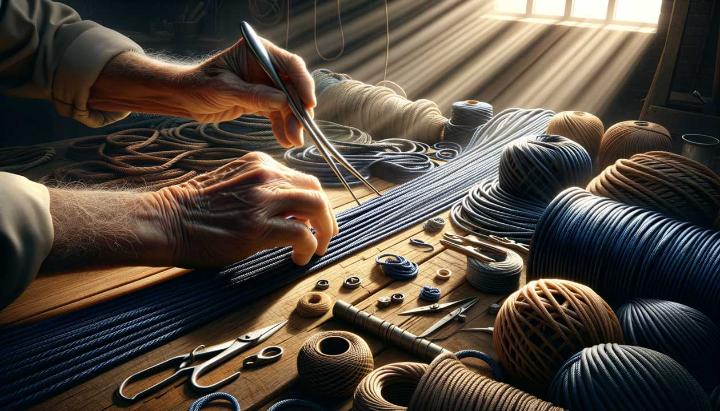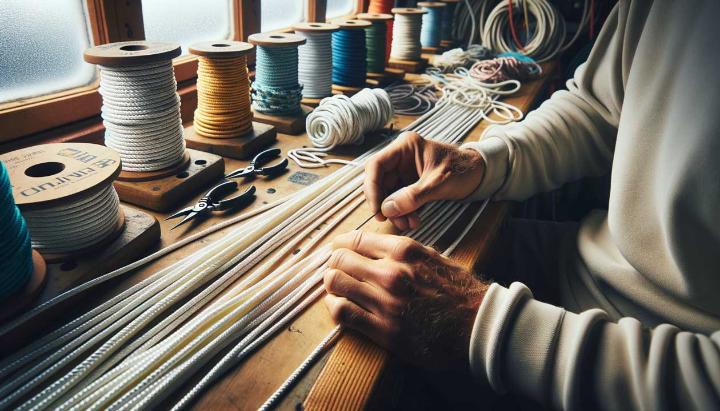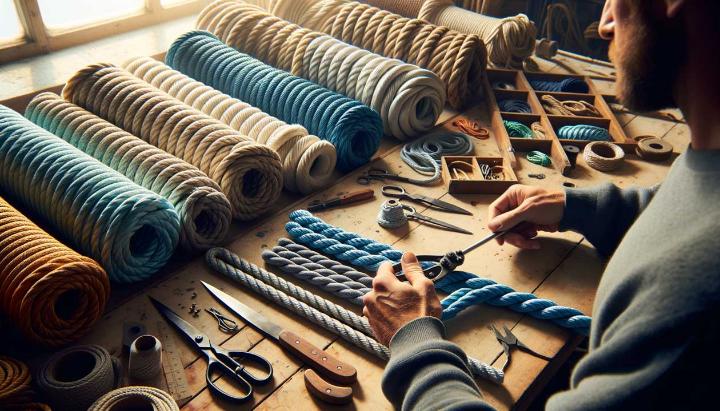Have you ever found yourself in a tangle with rope work, wondering if there's a secret tool that could make your life easier? Enter the world of rope fids and wire fids - the unsung heroes of splicing and rope manipulation. These ingenious tools are the key to unlocking the full potential of your rope projects, whether you're rigging a sailboat or crafting intricate knots for outdoor adventures.
In this comprehensive guide, we'll unravel the mysteries of rope fids and wire fids, exploring their unique characteristics and best applications. From the traditional wooden fid to the versatile 1 fid and the precision of wire fids, we'll dive into the materials that make these tools indispensable for both novice enthusiasts and seasoned professionals alike.
Join us as we navigate through the world of fids, uncovering expert techniques, innovative projects, and the secrets to choosing the perfect fid for your needs. Whether you're a DIY enthusiast or a wholesale customer seeking high-quality rope solutions, this guide will equip you with the knowledge to elevate your rope work to new heights. Get ready to discover the best uses for rope fids and wire fids - your gateway to mastering the art of splicing and beyond!
Understanding the Rope Fid: Essential Tool for Rope Splicing
If you've ever found yourself wrestling with tangled ropes or struggling to create a secure splice, you're not alone. Let me introduce you to the unsung hero of rope work: the rope fid. This nifty tool has been a game-changer in my own sailing adventures, and I'm excited to share its secrets with you.
What is a Rope Fid and Its Purpose?
A rope fid is a tapered, pointed tool that's essential for splicing and manipulating rope strands. Picture it as a sailor's wand, magically weaving rope fibres together to create strong, reliable connections. I remember the first time I used a fid – it was like discovering a superpower for rope work!
The primary purpose of a rope fid is to separate strands of rope, allowing you to weave them back together in intricate patterns. This process, known as splicing, creates joins that are often stronger than the original rope itself. Isn't that incredible?

Common Materials Used for Rope Fids
Rope fids come in a variety of materials, each with its own unique characteristics:
- Wooden fids offer a traditional feel and are gentle on natural fibre ropes. They're my go-to for working with classic hemp or cotton ropes.
- Plastic fids are lightweight and affordable, perfect for beginners or occasional use. I keep a few in my toolkit for quick fixes.
- Metal fids are durable and precise, ideal for working with synthetic ropes. When I'm tackling a challenging splice on a modern yacht, these are my trusted companions.
Advantages of Using a Rope Fid for Splicing and Rope Work
Using a rope fid offers several advantages that make it indispensable for any serious rope enthusiast:
- Precision and control: The tapered design allows for accurate manipulation of rope strands, resulting in cleaner, stronger splices.
- Versatility: Fids can be used on various rope types and diameters, making them a versatile tool in your kit.
- Time-saving: Once you've mastered the technique, using a fid can significantly speed up your splicing process.
- Reduced rope damage: Proper use of a fid minimises fraying and weakening of the rope during splicing.
Have you ever tried using a rope fid? If not, I encourage you to give it a go. With a bit of practice, you'll be creating professional-looking splices in no time. Remember, the key is to choose the right fid size for your rope – generally, the fid length should be about 21 times the rope diameter. Happy splicing!
Exploring the Versatility of Wire Fids
As we dive deeper into the world of rope work, let's turn our attention to the wire fid - a tool that's revolutionised the art of splicing. Having used both rope and wire fids extensively in my sailing career, I can attest to the unique advantages that wire fids bring to the table.
Applications of Wire Fids in Rope Splicing
Wire fids are incredibly versatile tools that excel in various rope splicing techniques. Their slender, flexible design allows for precise manipulation of rope strands, making them particularly useful for:
- Tucks and buries: The wire fid's slim profile makes it perfect for creating neat tucks and deep buries, essential for strong splices in synthetic ropes.
- Working with tight weaves: When dealing with densely woven ropes, a wire fid can easily navigate through the tight spaces between strands.
- Splicing hollow-core ropes: The flexibility of wire fids makes them ideal for working with modern hollow-core ropes used in high-performance sailing.

Advantages of Wire Fids for Professional Splicers
Professional splicers often prefer wire fids for their efficiency and precision. Here's why:
- Dual-action capability: Wire fids allow for both push and pull operations, giving splicers more control over the splicing process.
- Reduced rope damage: The smooth surface of wire fids minimises friction, reducing the risk of fraying or weakening the rope fibres during splicing.
- Versatility across rope types: From traditional three-strand ropes to modern high-tech materials, wire fids adapt well to various rope constructions.
In my experience, the time saved using a wire fid on complex splices is significant. I recall a particularly challenging project involving Dyneema® rope where the wire fid's flexibility allowed me to complete an intricate splice in half the time it would have taken with a traditional fid.
While both rope and wire fids have their place in a rigger's toolkit, the wire fid shines when precision and efficiency are paramount. Have you tried using a wire fid in your rope work? If not, I encourage you to give it a go - you might be surprised at how it transforms your splicing technique!
Best Practices for Using 1 Fid
As an avid sailor and rope enthusiast, I've learned that mastering the use of a fid can make all the difference in your rope work. Whether you're splicing a new anchor line or repairing a frayed halyard, these best practices will help you get the most out of your fid and elevate your rope skills to new heights.
Selecting the Right Size and Material of Fid for the Job
Choosing the perfect fid is like finding the right dance partner - it needs to match your rope perfectly. Here's what I've learned over years of trial and error:
- Size matters: A good rule of thumb is to select a fid that's about 21 times the diameter of your rope. This ensures smooth passage through the rope strands without causing damage.
- Material considerations: For natural fibre ropes, I prefer wooden fids as they're gentle on the fibres. For synthetic ropes, metal fids offer precision and durability.
- Project specifics: Consider the complexity of your splice. For intricate work on thin ropes, a slender wire fid might be your best bet.

Techniques for Using a Fid Effectively and Safely
Using a fid is an art form that requires practice and patience. Here are some tips I've picked up along the way:
- Maintain a firm grip: Hold the fid like a pencil, close to the tip for better control. This helps prevent slips that could damage the rope or injure you.
- Work slowly and methodically: Rome wasn't built in a day, and neither is a perfect splice. Take your time to ensure each pass is precise.
- Use a marlinspike hitch: This simple knot can secure your fid to the rope, preventing it from slipping out during complex splices.
- Protect your hands: When working with wire fids or abrasive ropes, don't forget to wear gloves. Trust me, your hands will thank you later!
Maintenance and Care Instructions for Prolonging the Life of Your Fids
A well-maintained fid is a joy to use and can last a lifetime. Here's how I keep my fids in tip-top shape:
- Clean after each use: Wipe down your fid with a clean, dry cloth to remove any fibres or debris.
- Oil wooden fids: For wooden fids, I apply a light coat of linseed oil every few months to prevent drying and cracking.
- Inspect regularly: Check for any burrs or rough spots that could snag rope fibres. Smooth them out with fine-grit sandpaper.
- Store properly: Keep your fids in a dry place, preferably in a protective case or roll to prevent damage. Learn more about proper storage options here.
Remember, a fid is more than just a tool - it's an extension of your hands in the intricate world of rope work. By following these best practices, you'll not only improve your splicing skills but also develop a deeper appreciation for the art of rope craft. Have you got any fid care tips of your own? I'd love to hear about them in the comments below!
Applications and Projects for Rope and Wire Fids
Now that we've explored the ins and outs of rope and wire fids, let's dive into the exciting world of projects and applications where these versatile tools truly shine. As a seasoned sailor and rope work enthusiast, I've had the pleasure of using fids in countless projects, each one teaching me something new about the art of splicing and rope manipulation.
Understanding Rope and Wire Fid Tools
Before we jump into specific projects, it's crucial to understand the different types of fids and their unique characteristics:
- Rope fids: Typically made of wood, plastic, or metal, these are ideal for working with natural fibre ropes and basic splicing tasks.
- Wire fids: Slender and flexible, these are perfect for intricate work with synthetic ropes and tight weaves.
- Hollow fids: These tubular tools are designed for working with hollow-core ropes, allowing for easy threading and splicing.
Choosing the right fid size is crucial for successful splicing. As a rule of thumb, your fid length should be about 21 times the rope diameter you're working with. This ensures smooth passage through the rope strands without causing damage. Explore further applications with the right equipment through our comprehensive guide here.

DIY Fid Projects for Rope Splicing
One of the most rewarding aspects of working with fids is the ability to create your own custom tools. Here's a simple guide to crafting a basic wooden fid:
- Select a hardwood dowel slightly larger than your desired fid diameter.
- Use sandpaper to taper one end of the dowel to a smooth point.
- Shape the other end into a comfortable handle.
- Apply a coat of linseed oil to protect the wood.
With your DIY fid in hand, why not try a beginner-friendly splicing project? An eye splice is a great starting point:
- Unlay the rope strands about 12 inches from the end.
- Form a loop of the desired size.
- Use your fid to weave each strand back into the rope's body.
- Taper the splice by gradually reducing the number of tucks.
Remember, practice makes perfect. Don't be discouraged if your first attempts aren't flawless – every splice is a learning opportunity!
Advanced Techniques Using Fids in Wire Work
For those ready to take their skills to the next level, wire fids open up a world of possibilities in advanced rope work. One impressive project I've tackled is creating a Dyneema® soft shackle:
- Use a wire fid to create a buried splice in hollow-core Dyneema® rope.
- Form a loop and lock it with a Brummel splice.
- Create a stopper knot for the other end.
- Adjust the loop size and trim excess material.
The result is a lightweight, strong alternative to traditional metal shackles – perfect for sailboat rigging or high-performance applications. For more detailed instructions on working with Dyneema® ropes, you can refer to our [Mastering Eye Splice Dyneema for Off-Road Adventures guide](a href="/blog/insights-4/mastering-eye-splice-dyneema-for-off-road-adventures-100" target="_blank">here
.Whether you're a DIY enthusiast, a professional rigger, or somewhere in between, fids are invaluable tools that open up a world of creative possibilities in rope and wire work. What projects have you tackled with your fids? I'd love to hear about your experiences and any unique applications you've discovered!
Rope fid and wire fid are indispensable tools for splicing and rope work, each serving unique roles. Rope fid, available in wood, plastic, or metal, excels in precision splicing of natural and synthetic ropes, reducing damage. Wire fid, with its slender design, is ideal for intricate tasks, including working with hollow-core ropes and tight weaves. Selecting the right size and material—like wooden fids for natural ropes and metal for synthetic—enhances efficiency and durability. From basic splices to advanced techniques like Dyneema® soft shackles, these tools offer versatile solutions. Experiment with both to elevate your rope projects!
Request More Information About Rope Fids
Interested in discovering the best fid for your rope projects? Fill in the form above to learn more about tailored solutions that fit your needs!